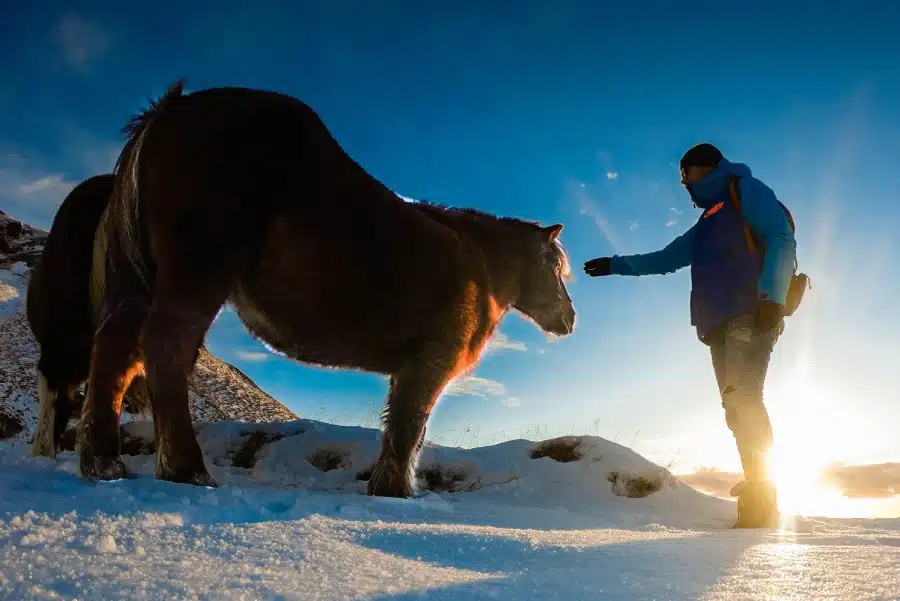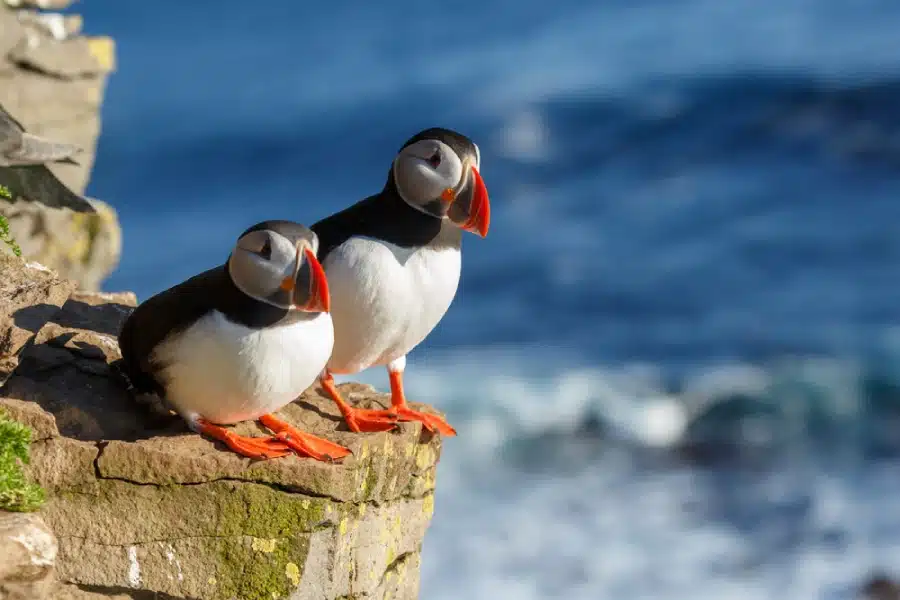TL;DR: Iceland offers a unique wildlife experience, from the Arctic fox, the only native land mammal, to majestic whales and adorable puffins. Climate and island geography shape its distinct animal populations, with a mix of native and introduced species thriving in its harsh environments.
Main Points:
- Climate influences wildlife diversity.
- Iceland’s location affects land and marine animal populations.
- Arctic foxes, reindeer, and Icelandic horses are key land animals.
- Whales and seals dominate the marine scene.
- Puffins and ravens are notable bird species.
- Few large animals and predators due to harsh conditions.
Iceland, with its breathtaking landscapes and unique ecosystem, offers a chance to witness incredible wildlife in its natural habitat. Whether you’re a nature enthusiast or just curious about Iceland’s unique creatures, this guide has you covered. We’ll share some interesting info about the diverse creatures you might encounter on your Icelandic adventure.
From majestic whales to adorable puffins, prepare to be amazed by Iceland’s animals.

Wildlife in Iceland: What You Should Know
Climate has a big impact on wildlife. Temperature, rainfall, and other factors have a significant amount of influence on how animals evolve and which animals thrive.
Islands also influence wildlife. While some birds and ocean animals can easily leave an island, land animals that emerge on or are brought to an island are mostly limited to that island. The climate, availability of food, presence or lack of predators, terrain, and many other influences eventually shape the development of those land animals.
With that in mind, let’s look at how Iceland’s climate and location influence the animals that live here.
Iceland’s Climate and Location: Influence on Icelandic Wildlife
Iceland has a colder climate than is found in much of the US and Europe.
Parts of the coast, including Reykjavík and many of the most populated areas, have a subpolar oceanic climate. The rest of the coast and entire interior — the Icelandic Highlands — is classified as a tundra.
There isn’t a lot of plant growth. Temperatures are mild or low, especially in the winter. Much of the island is rocky and hard to make into a home, even for animals.
As an island, there are limited opportunities for land-based wildlife to reach our country. With that in mind, it may not surprise you to learn that there aren’t many native land animals in Iceland. The Icelandic Institute of Natural History tells us that the only land mammal native to the country is the Arctic fox.
However, more animals have been introduced to Iceland since the first settlers arrived in the ninth century. These Icelandic land mammals have endured, evolved, and thrived both as livestock and in wild populations.
Let’s take a closer look.
Land Mammals in Iceland
Iceland’s unique landscape and location have shaped its wildlife population, creating a blend of native and introduced species. Let’s explore what animals you might see.
Arctic Foxes
The only native land mammal in Iceland, the Arctic fox is a true survivor. This adorable creature dons a thick, white winter coat that takes on a brown-grey hue in summer. This allows it to blend seamlessly into its surroundings.
Keep your eyes peeled for these playful foxes in remote areas like the Highlands and the Westfjords.

Reindeer
Since the 18th century, reindeer have become a permanent part of the Icelandic scenery. Once domesticated, they were once thought to be almost extinct after experimental efforts to use them as livestock ended.
However, a wild population of these majestic animals was identified in the 1930s. Today, reindeer are mostly found in the eastern region.
Icelandic Horses
This unique breed was brought over by Norse Viking settlers and has been a purebred in Iceland for over 1,000 years. They’ve perfectly adapted to the island’s terrain. Icelandic horses are popular for riding tours and offer a unique way to experience the Icelandic landscape.
Icelandic horses are common, at least by the standards of wildlife in Iceland. You can find them across the country. Distinct groups of Icelandic horses are used as pets as well as a food source in our country.
Many of our customers stop their vacation camper vans to take photos and observe these creatures in their natural habitat. It’s always important to be careful around wildlife, but you can offer them some bread as a treat (it’s almost like candy for these horses!) to get a closer look.
Marine Mammals
There is an incredible diversity of Iceland wildlife in the icy waters off the coast. This makes our country a world-renowned destination for whale watching.
Whales
Iceland provides an unforgettable experience for anyone who wants to see whales in their natural habitat. While you can never guarantee a whale spotting, there is a whale-watching season where your odds of seeing a whale increase.
Prime whale-watching season spans from April to September. If you go on a whale-watching tour or watch the water from the right place, you might spot various species, such as:
- Humpback whales
- Minke whales
- Orcas (killer whales)
- Sperm whales
Seals
The Icelandic coastline is home to two resident seal species:
- Harbor seal: These playful and curious animals in Iceland can be seen basking on rocks and beaches all around the island. There are particularly large colonies found on the Northern coast and are the most common seal in Iceland.
- Grey seals: Larger than their harbor seal counterparts, grey seals prefer remote coastlines and rocky shores. You might spot them on the north and west coasts.
Birds in Iceland
Iceland has a rich and varied bird population. These species are adapted to Iceland’s unique coastal cliffs, volcanic terrain, and freshwater lakes. Here are some examples:
Puffins
The Atlantic puffin is undoubtedly Iceland’s most popular and iconic bird. They’re a must-see for wildlife enthusiasts. Guide to Iceland explains that a majority of North Atlantic puffins (about 60%) make their home on the cliffs of Iceland.
These adorable seabirds are known for their brightly colored beaks and comical expressions. They nest in large colonies on dramatic cliffs during the breeding season from May to August. Visiting their nesting grounds is an especially popular activity for visitors.

Ravens
Ravens are intelligent and adaptable birds commonly seen across Iceland. They’ve been part of Iceland’s landscape for thousands of years, making them some of the oldest inhabitants.
They hold a special place in Icelandic culture, too. Ravens are often seen as wise messengers, protectors, and even companions of the god Odin in Norse mythology.
Frequently Asked Questions about Iceland Animals
What animals are only found in Iceland?
The Arctic fox is the only native land mammal in Iceland. It has adapted to the harsh environment and plays a crucial role in the island’s ecosystem.
What are the Icelandic national animals?
The gyrfalcon is considered Iceland’s national bird. This majestic bird of prey is a powerful symbol of the country, reflecting its strength and resilience.
What predators live in Iceland?
Because there aren’t many large land mammals, Iceland has few natural predators. The Arctic fox is one of them, and it hunts small animals and scavenges for carrion. Also, predatory birds such as the gyrfalcon and eagles prey on smaller birds and mammals.
Does Iceland have large animals?
As mentioned above, Iceland doesn’t have many large animals. The largest you’ll likely see is a horse or reindeer. This is because of our country’s isolated and harsh natural environment.
Remember, only the small Arctic fox thrived as a wild animal in Iceland. It adapted to the demands of our island, but that’s by no means an easy task for any animal.
However, the water surrounding our island is home to various large marine animals, such as whales and grey seals.
Does Iceland have grizzly bears?
No, Iceland doesn’t have any permanent populations of bears, not even grizzlies. The island’s unique ecosystem and isolation have kept these big predators away.
However, there is a certain breed of bear that does sometimes visit Iceland.
Does Iceland have polar bears?
Polar bears are a very rare breed of land mammal that can travel significant distances on water. They do this not by swimming, but by riding on icebergs and chunks of ice floating in cold ocean waters.
Occasionally, a polar bear will make its way to our country as ice floats on ocean currents toward Iceland. These bears come from Greenland, as Iceland’s natural history museum Perlan explains. That island has a permanent polar bear population, while Iceland doesn’t.
Polar bear sightings occur roughly once every several years. However, they have become somewhat more common, although still very rare in the big picture, in the 21st century.
When a polar bear sighting is confirmed, government authorities, wildlife experts, and the Icelandic Coast Guard will investigate. If a sighting is confirmed, every effort is made to tranquilize the bear and return it to its natural habitat.
Unfortunately, polar bears arriving in Iceland can be extremely hungry and disoriented. Their size, strength, and hunger make them a legitimate and serious threat to both local residents and livestock. For that reason, a small minority of polar bear encounters lead to the bear being euthanized.
Ready to Experience Iceland’s Wildlife Wonder
Now that you know what animals live in Iceland, it’s time to go on an adventure and see these amazing creatures in their home. We may be biased, but we think the best way to see all the sights Iceland offers is through a road trip adventure! It’s an opportunity to travel where you want, when you want, all across the splendid natural beauty of our nation.
Explore Iceland with the coziest camper rental. Discover the island at your own speed surrounded by its natural beauty and diverse wildlife.
Back to blog